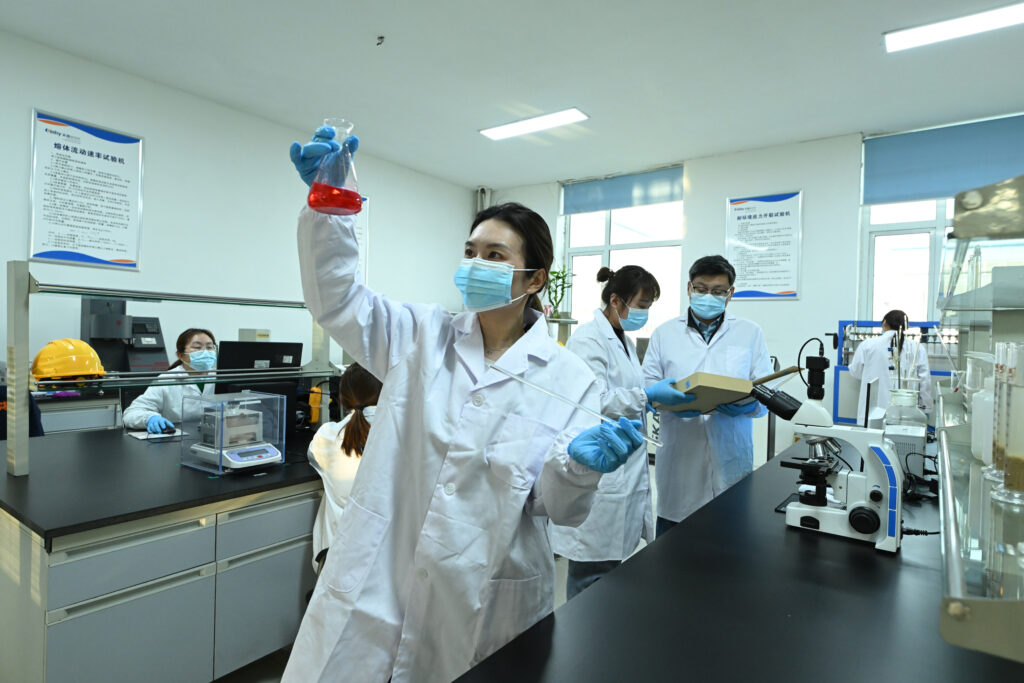Geomembrane UV resistance test and discussion
The national standards GB/T17643-2011 and CJ/T234-2006 both stipulate the anti-ultraviolet performance indicators of geomembranes, but the difference from the American standard GM 13 directive is that after 1600 hours of anti-ultraviolet performance, the geomembrane After the test, it is evaluated by whether the retention rate of OIT before and after the test is ≥50%. The national standard stipulates that one of the two evaluation methods is the atmospheric pressure oxidation induction time or the high-pressure oxidation induction time; however, the evaluation method is specified in GM 13. It is limited that after the ultraviolet resistance test, high-pressure oxidation induction time needs to be used for evaluation, and corresponding explanations are given, as shown in Figure 1 below:

Figure 1 Explanation of the selection of high-pressure oxidation induction time for the ultraviolet resistance evaluation method of geomembranes in the American standard GM 13 directive
In response to the above situation, the laboratory conducted ultraviolet resistance tests on geomembranes with four different HDPE geomembrane formulas, and observed and analyzed the changes in mechanical properties, atmospheric pressure oxidation induction time, and high-pressure oxidation induction time before and after 1600 hours of ultraviolet irradiation.
The test conditions for the geomembrane UV resistance test are as follows:
①Irradiance: UVA-340 lamp, 340nm wavelength, irradiance 0.76W/㎡
②Temperature: The blackboard temperature is (75±3) ℃ during drying, and the blackboard temperature is (60±3) ℃ during condensation.
③Cycle: irradiation period 20h, condensation 4h, total cycle test 1600h.
Figure 2 below shows the laboratory sample preparation and test process:


Figure 2 Sample preparation and test process
The test data of the four test formulas are shown in Table 1 below:
Comparison of test data on UV resistance of different formulas

As shown in Table 1, the change rates of breaking strength, breaking elongation, yield strength and yield elongation of the four types of geomembranes after the 1600h UV resistance test were all small, and the retention rates were all above 90%. Due to the influence of interfering factors such as the allowable error of the test, the mechanical performance index under 1600 hours of UV resistance cannot be used as a reasonable basis for evaluating the UV resistance of the geomembrane.
In terms of the retention rate of atmospheric oxidation induction time, the 3# and 4# formulas meet the index requirement of OIT retention rate ≥ 50% before and after the test, while the 1# and 2# do not meet the requirement, and the data gap is large. For the comparison of data on normal pressure oxidation induction time and high-pressure oxidation induction time in the standard, the test results of the four formulas are shown in Table 2 below.
Table 2 Evaluation of the UV resistance of geomembranes by normal pressure and high pressure oxidation induction time

It can be seen from Table 2 that
1) In terms of retention rate: The antioxidants in the geomembrane formula may have changed under the irradiation of ultraviolet rays. The products are more sensitive to the high temperature test, resulting in lower retention rates for the normal pressure method (200℃) than the high pressure method (150℃). On the low side, the correlation of the experimental data becomes worse. Therefore, it is more reasonable to recommend high-pressure OIT for most performance evaluation, given its low variance and rarity of high temperature environment.
2) Judging from the initial value of OIT before the test: At present, the high-pressure oxidation induction time(high-pressure OIT) value of most many HDPE geomembrane formula on the market is less than 400 minutes. Thus, it is important for customers to acknowledge the right OIT testing technique and pay attention to this metric, especially if the customer intend to expose geomembrane under direct sunlight or in high temperature environment.
Currently, the antioxidant masterbatch in the geomembrane formula system includes: nitrites (140°C~300°C), hindered phenols (0°C~300°C), and sulfides (0°C~200°C). ℃), hindered amines (0℃~150℃), etc.; among them, the temperature tolerance range of hindered amine antioxidants is lower (0℃~150℃), and the 200℃ tested by normal pressure OIT is higher than that of hindered amine antioxidants. The effective temperature of the oxygen agent, while the high-pressure OIT detection temperature of 150°C does not exceed its tolerance temperature, so the high-pressure OIT detection can truly reflect the antioxidant effect of hindered amine antioxidants.
In addition, hindered amine antioxidants will be converted into decomposed new substances with peroxycyclohexanedione, cyclopentenone, cyclopentadienone and other structures under light conditions. This transformation product still has antioxidant properties. Performance, geosynthetic materials such as geomembranes still have the function of antioxidant protection, but their stability is low and there is a problem of high temperature intolerance. Therefore, normal pressure OIT under high temperature testing cannot truly evaluate the resistance to ultraviolet irradiation. Real level.
On May 27, 2023, in Beijing, Tinhy Geosynthetics Co., Ltd. was invited to participate in the first meeting of the revision of the national standard “Geosynthetic Materials Polyethylene Geomembrane”. During the meeting, the above existing UV resistance performance evaluation issues were also discussed. After sufficient discussion, the method in GM 13(widely acknowledge internationally) will be clarified and included in the standard revision work in 2024.
The revision and implementation of the new national standard will bring new opportunities and challenges to geomembrane products, and will require manufacturers to pay more attention to the technology and quality control of the products themselves, providing a baseline for the sustainable, healthy and high-quality development of the industry.
Quality Control Center
November 17, 2023


